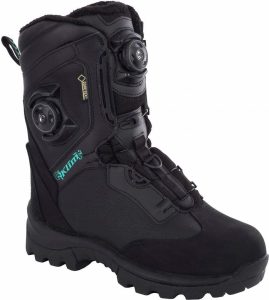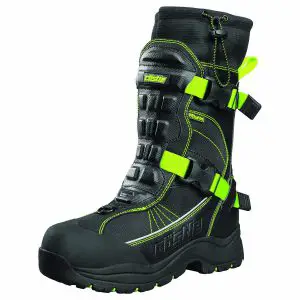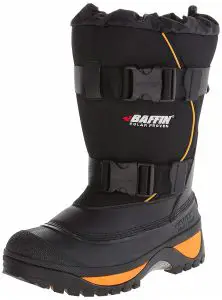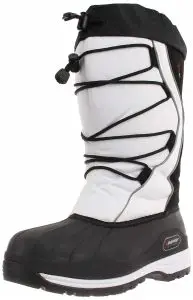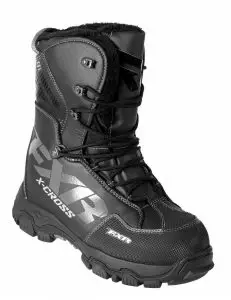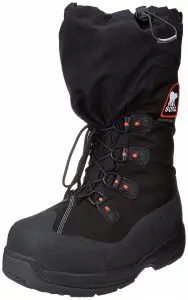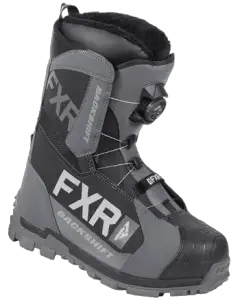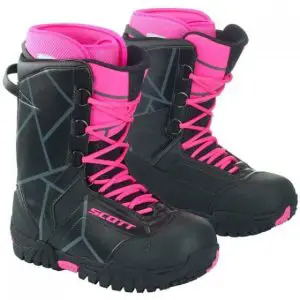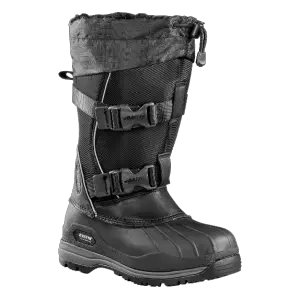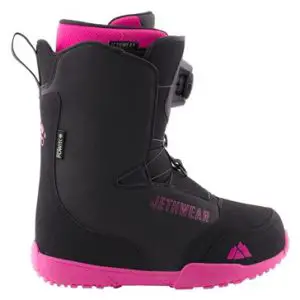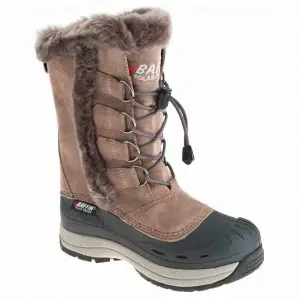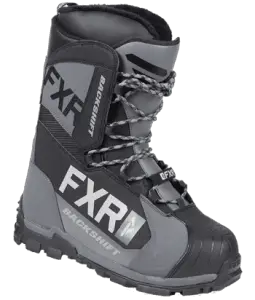Snowmobile boots impact the riding experience of the riders. The right pair of boots makes it convenient to snowmobile while protecting your feet and lower legs. There is a wide range of snowmobile boots available in the market and choosing the right one can be tricky for a rider. The best snowmobile boots must ensure excellent heat retention, be comfortable to wear and provide excellent traction for stability.
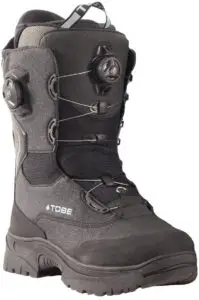
What to Look for When Selecting the Best Snowmobile Boots?
While tourists or individuals who go snowmobiling once in a while can make do with regular snow boots, enthusiasts or people whose livelihood depends on snowmobiles will need snowmobile boots. The right pair of shoes for one rider may not be ideal for another rider. Here are a few things to look for when selecting the best snowmobile boots. They can aid you in choosing the right pair for your needs.
Waterproof
When snowmobiling, your feet will come in contact with the snow. It may melt and seep into socks, making you wet and cold. Not only will it cause you discomfort, but it may affect your ability to handle the snowmobile. Therefore, you must consider waterproof snowmobile boots that protect your feet and socks from getting wet. At the very least, the best snowmobile boots should repel water up to some degree.
Adequate waterproofing also reinforces the level of insulation in your best snowmobile boot. A waterproof boot is made of materials like leather or rubber and might include an extra membrane attached to the lining. These winter footwear treatments are designed to keep moisture out as much as possible – while still making the fabric breathable and comfortable. For this reason, features like breathability and moisture-wicking often accompany a waterproof technology. You should consider buying snowmobile boots that have lightweight and durable shell constructions. The waterproof layers should not add to the overall weight of your boot. Waterproof nylon shells, water/wind-resistant polyurethane-coated synthetic textile, and waterproof vulcanized rubber shells are the best materials to search for. Some other waterproof technologies you might come across in product descriptions include:
- Gore-Tex membrane: a Gore-Tex membrane is designed to be waterproof and breathable. It is an ideal winter footwear technology because it keeps rainwater or melted snow away from the boot – and still allows sweat to evaporate. You will find this technology in high-performance snowmobile boots that feature comfort and optimized breathability. The membrane is also windproof and helps to keep the insulation layers dry.
- Castle DRY-X waterproof membrane: a fully-integrated Castle DRY-X membrane is another popular snowmobile boot technology. It features weatherproofed shells like 1000D nylon upper materials with Armstrong PU coated leather.
- Baffin waterproofing technology: Baffin boots are made of fully-molded rubber, waterproof leather, waterproof neoprene, and nylon. Combined with breathable membranes, this technology keeps your feet dry by preventing water from sneaking in and allowing sweat vapors to escape.
Insulation
Along with protecting your feet from snow and moisture, the best snowmobile boots must keep them warm and comfortable. Choose a pair that has adequate insulation for the climate conditions that you will be facing. Ideally, the best snowmobile boots should have around 600g of insulation. You will need more insulation for extremely cold weather. A few shoes have removable insulation that can be pulled out for drying it faster. Some manufacturers provide the temperature ratings that their snowmobile boots will withstand. You can consult these and check if the boots are suitable for the weather conditions in your area. Insulation becomes even more important for riders who don’t like to wear heated socks or whose feet get really cold.
You will find temperature ratings such as -40°F and -60°F in various product descriptions. These ratings are a good measure of how suitable the best snowmobile boot is for your preferences. Different types of insulation will have different temperature ratings, and some popular insulation systems are discussed below. Features like water resistance and moisture-wicking often overlap with the waterproof category – so good waterproofing and insulation always make the best snowmobile boots.
- 3M Thinsulate: this water-resistant insulation is lightweight and helps to keep your feet dry and comfortable. It is a pre-compressed insulation layer for added warmth – minus the weight of unnecessary layers that cause bulkiness.
- Multi-layer insulation system: snowmobile boots with multi-layer insulation combine the benefits of each layer into one reinforced insulation. They are designed to wick away moisture even during extreme weather conditions. This form of insulation is an ideal moisture control system that keeps your boot’s foam dry by preventing water from getting in. There is also a skin-friendly layer that is soft and smooth to the touch, allowing you to wear your boots comfortably while snowmobiling. The membrane layer is used to reflect heat energy back into the boot, which keeps your feet warm. Aluminum insoles may also be used to reflect the cold away from your boot. These multiple layers are stacked in different combinations to deliver different temperature ratings for your preference.
- Omni-heat reflective lining: snowmobile boots with Omni-heat lining rely on this thermal reflective technology for improved insulation. The result is that your feet remain comfortable and warm even in sub-zero conditions. The reflective lining creates thermal insulation for your boots, so you can use them in various snowmobile contexts.
- Thermolite insulation: another common footwear insulation system is Thermolite insulation. These liners create the perfect warmth for different temperature ratings. You might find weight values like 200g for indicating the strength of the insulated lining.
Sole and Treads
The grip strength of soles is an essential thing to consider when selecting the best snowmobile boots. Snow is wet and slippery, and you need boots that are designed to handle these conditions. They generally have aggressive tread patterns and deep lugs that can dig into the snow for a sturdy grip. A few of them may additionally feature metal studs for further enhancing the grasp. Snowmobile boots with a good grip are crucial if your snowmobile gets stuck, and you have to push or drag it. You won’t be able to generate adequate effort to move the sled if your shoes don’t provide enough traction on the snow.
Lacing System
Tying regular shoelaces while wearing gloves is difficult, but it becomes almost impossible when you are out riding a snowmobile in the ice and buried under layers of clothing. The best snowmobile boots come with a lacing system known as BOA. Instead of using regular laces, they may employ stainless steel wires. They feature a knob that you can turn for tightening or loosening the laces. You don’t have to remove your gloves for the same. Other snowmobile boots may use buckles or a drawstring for tightening the shoe. You can choose a snowmobile boot whose lacing system suits your needs and budget.
Safety Features
Advanced riders who engage in off-trail snowmobiling may want additional safety features on their snowmobile boots. They may require a kick plate on the toe-end of the boot. It is thick padding that protects the toes from impacts as well as allows you to shake the snow off the sled. Impact plates and ankle protectors are other safety features that can protect the rider from bushes, shrubs, and stones. If you ride fast, then you may consider these best snowmobile boots with additional safety features.
Warmth
Any snow boot must keep your feet toasty and protected from the snow and wind. A decent snowmobile boot goes above and beyond to keep your feet dry and warm in harsh circumstances and high winds created by fast riding. As a result, a snowmobile boot’s warmth plays an essential part in its overall performance.
While a good snowmobile boot has to be warm, there is some variation. Firstly, we’ll mention that a handful of footwear brands include a temperature rating, though we always advise taking them with a grain of salt. You may read great ratings such as -25°F or below, but unlike sleeping bags, there is no defined rating system for measuring the warmth of snowmobile boots. Plus, many factors come into play here, including your activity level, circulation, sock type, and thickness, as well as the fit of the boot. We enjoy reading and noting temperature ratings, but we always think they are generous and look for other specifications as well.
However, insulation weights can give you a better idea of how warm the snowmobile boots will be. For reference, many light to midweight snowmobile boots have 400-600 gram insulation, while a real cold-weather boot has more insulation and a thick liner.
Weather Protection
Weather protection is important, particularly when it comes to snowmobile boots. Since you will be riding through severe climate conditions and fast winds, keeping your feet dry and warm would be an absolute essential.
Wet feet are certainly not happy feet, particularly when the water is marginally above freezing temperature. That is why snowmobile boots must be water-resistant. GORE-TEX, rubber, and nylon are all excellent shell materials to look for. Thinsulate is a nearly universal kind of insulation.
Lacing System
Snowmobile boots, like snowboarding boots, come with both regular and BOA laces.
Regular laces allow you to pull everything down before tying your knot. The system is easy, however, the process is a bit tedious because you are out in the snow and buried under various layers of clothing.
BOA laces include a dial that you may twist to adjust as per your level of comfort. This boot-lacing mechanism appeals to many snowmobile riders. It’s simpler to adjust, more comfortable, and provides a steady, moderate pressure, holding the shoe snugly in place without the hotspots or friction of other shoe attachment methods. It also does not loosen or untie the knot. This lacing system is not necessary, flawless, or cheap, but if you have money, it’s arguably the best attachment option available.
Traction
Dependable traction is vital. This will provide stability on your sled during times when you have to stand up or lean to one side. Besides, thick traction also provides a stronger grip in the snow when walking around.
The soles of snowmobile boots are often made of synthetic rubber or polymer, which allows the treads to remain flexible and give adequate grip even in extreme temperatures. Moreover, soles made from these compounds do not harden when temperatures decrease, which allows them to continue on slick surfaces. Tread patterns are aggressive and feature deep lugs that prevent snow buildup and give sure-footed traction in snow and on ice surfaces.
Comfort
Comfort is an essential consideration with footwear, and the same holds true for snowmobile boots. Most snowmobile riders think that the greater the protection provided by the boots, the less comfortable they are. Fortunately, this isn’t always the case.
For long adventures, you will want to ensure that you pick the snowmobile boot that offers you warmth, comfort, and safety. If you aren’t comfortable riding for long periods at a time, you may find yourself with less riding time.
At the same time, comfort is a highly subjective assessment. What we consider the most comfortable design might not feel comfortable to your foot. Yet we know one thing it surely starts with a proper fit. So, make certain that you get that right.
This can be done by trying various options while wearing your snowmobiling socks. Then, choose a snowmobile boot that is neither too tight nor too narrow. Or be so short that your toes are always curled up.
There should be just enough space for the warmth created by your foot to circulate. However, not so much that your feet are swimming around inside. Or that each stride seems like the boot is being removed.
Budget
In general, there is a direct relationship between the price of a boot and the level of protection offered (i.e., you get what you are paying for in terms of snowmobile boots). Unfortunately, you cannot expect to acquire a pair of competition boots for $100. Most quality snowmobile boots cost between $300 and $500. Of course, there are pairs of snowmobile boots that are below this price range, but you can expect less quality as well as less frequent and continuous use from them.
If you only go out for a few short rides during the winter, a less expensive pair of snowmobile boots may suffice. There are many viable options that offer quality coverage for high-end boots. However, if finances allow, we advise stretching the budget to obtain premium boots since the technological gap between entry-level and quality-level is significant.
By the way, here’s a little budget advice. The “BOA” lacing system, as discussed, is now used by the majority of boot manufacturers. If you like a certain footwear, see if it comes with regular laces as well.
If so, it will undoubtedly be cheaper in this form (often by nearly $100). Without a doubt, the “BOA” system simplifies your life by keeping your boots snug and adjusted throughout your adventures. On the contrary, regular laces give you the ability to purchase the same quality of boots while costing less.
10 Best Snowmobile Boots – 2023
Here are the ten best snowmobile boots available today from different manufacturers that snowmobile riders can consider.
10. Kamik Greenbay 4 Cold Weather Boots
The Greenbay 4 cold weather boots from Kamik are one of the top selling best snowmobile boots available in the market. They are designed for maximum protection in deep snow as well as slushy terrains and can be used in temperatures as low as -40°F. A removable 8mm thermal guard liner retains heat and provides maximum protection against cold. It also has excellent moisture wicking capabilities. The 600-denier nylon upper of the Greenbay4 boots is waterproof and has an adjustable snow collar. A hook and loop strap on the middle part of the boot ensures a snug fitting. They feature Kamik’s innovative RubberHe outsole that is lighter and offers maximum traction than natural rubber. The Greenbay 4 boots are available for both men and women.
9. KLIM Klutch GTX BOA Boot
The Klim Klutch GTX Boa boot is one of the best snowmobile boots for female enthusiast riders. It boasts of 600g of Thinsulate insulation for keeping the foot warm even in harsh weather conditions. The boot features the Boa lacing system that makes it easier to wear and remove it. Its Gore-Tex membrane protects water, and the moisture-wicking liner ensures ample air circulation. The durable nylon exterior and dual durometer outsole make the boot lightweight and sturdy. Locking eyelets allow the wearer to adjust the fitting of the boot and are reinforced with synthetic leather for added durability. Klim also manufactures the Adrenaline GTX snowmobile boot which has the same characteristics but is designed for male riders.
8. Castle X Barrier 2 Boot
When it comes to the best snowmobile boots, the Barrier 2 from Castle X is another excellent offering. The Barrier 2 boot is insulated by a 3-layer Merino wool blend along with perforated foam for maximum warmth. Its insole has a metallic layer for reflecting body heat and can be removed if required. An air mesh wicks away moisture and keeps the foot dry. It can be worn in temperatures as low as -60ºF. The boot has a 1000D nylon upper and is complemented by the durable Armstrong leather that has a polyurethane coating. It comes with the Dry-X membrane from Castle X for complete waterproofing. Its Castle X quick connect makes it easy to get in and out of the boot. The Barrier 2 is available in men and women variants.
7. Baffin Wolf Men’s Snow Boot
The Wolf Men’s boot from Baffin is a great choice for male riders who ride in cold weather. As one of the best snowmobile boots, the Wolf Men’s Boot has a double-weaved 900 Denier nylon upper to provide protection from water. A Baffin liner provides heat retention and can be removed if required. It has a temperature rating of -40ºF making it ideal for most riders. Its polar rubber outsole is durable and has excellent grip. The boot has been designed for enhanced breathability and maximum comfort. It has a double buckle system instead of laces for easy wearing and removal. A locking snow collar further enhances protection. Male riders who want a warmer boot can consider the Selkirk variant from Baffin that has a temperature rating of -94ºF (-70ºC).
6. Sorel Women’s Whitney Tall Lace Boot
Sorel is known for its heavy-duty winter footwear. Its Whitney Tall Lace boots are some of the best snowmobile boots offering a heavy duty option ideal for extreme conditions. They are suitable for temperatures as low as -100°F (-73.3°C). The upper part of the shoes is crafted from PU coated synthetic textile and shields the foot from water and wind. A drawstring allows the wearer to adjust the shoes as per their preferences. The 13mm Sorel Meltdown midsole keeps the feet warm. Its aero-trac non-loading outsole features rubber shell for waterproofing. Their Omni-Heat lining keeps the body heat locked for maximum protection from cold. The Glacier XT boots are available for both male and female riders.
5. Baffin Women’s Icefield Snowmobile Boot
The Baffin Women’s Icefield snowmobile boot is a great option for female riders. It is one of the best snowmobile boots when it comes to keeping feet warm. Its double B-Tek insulation and double aluminum sole make it suitable for temperatures as low as -148ºF(-100ºC). Its shell is crafted from Arctic Rubber and the Outsole from Polar Rubber. A removable liner enhances protection further while the waffle-comb footbed ensures a steady grip. The webbed lacing provides an adaptable and snug fitting. It features a Diamond-Lite insulated upper and a nylon snow collar for complete waterproofing.
4. Tobe Nimbus Boot Boa
Tobe has designed its Nimbus Boa Boot considering the needs of snowmobile riders. It features the dual-Boa Coiler System that makes it easy to wear and remove the boot while ensuring a snug fitting. The outsole of the boot is made from natural rubber for maximum durability and optimum grip. A Sympatex membrane makes the outer layer of the boot completely waterproof. The boot has optimum breathability and its liner wicks moisture for keeping the foot dry. Tobe manufactures it Nimbus Boot BOA in different sizes and male and female variants.
3. DSG Women’s Rime Boot with Boa
The DSG Rime Women’s Boot is one of the best snowmobile boots for women. It combines comfort with functionality and can be worn in temperatures up to -40ºF. Its Intuition foam liner ensures maximum warmth and molds to the foot over time for added comfort. The boot features the Boa system making it easier to wear than shoes with laces. Its outsole has aggressive lugs that offer excellent traction on challenging terrains. A cuff is provided to minimize pressure on the calf while the toe cap, heel counter and side walls are all reinforced. It is waterproof and windproof ensuring complete protection in unfriendly weather conditions.
2. FXR X Cross Boot (Lace-up)
FXR is a brand famous for its performance sportswear. Its FXR X Cross boot is a great option for enthusiast snowmobile riders. It is a lace-up boot with an ankle lock system for securing the lace. It comes with 600g insulation making it ideal for temperatures up to -40°(F). A thermostatic midsole along with a fixed liner with fur keeps the foot warm and snug. The high traction outsole of the FXR boot has enhanced grip to prevent the wearer from slipping. It has a large toe kick area for easy cleaning of snow and ice. The FXR X Cross Boot has a unisex design and is suitable for male and female riders. A Boa variant of the boot is also available for riders who don’t want a lace-up boot.
1. Sorel Men’s Blizzard XT Snow Boot
Sorel’s Blizzard XT Snow Boot is a great choice for riders searching for a premium offering. It comes with two midsoles – a removable 13mm Sorel midsole and a 12mm EVA midsole. Its Omni-Heat reflective lining ensures maximum heat retention for keeping the foot warm. The outsole of the boot features multidirectional lugs for providing superior traction on slippery terrains. Its upper part has a waterproof construction and a barrel lock for preventing the snow from entering. The boot is designed for extreme weather conditions and can be worn in temperatures as low as -100°F (-73.3°C).
FAQ’s
What boots should I wear snowmobiling?
Since snowmobiling can be severe, having to experience various elements and weather conditions. It demands a more intense level of protection and security from its gear. While tourists who go for riding once In a while can do with regular footwear, investing in quality snowmobile boots is necessary if you’re serious about riding.
Snowmobile boots are some of the most secure boots available on the market because they provide great protection to your feet, ankles, calves, and shins. They also provide warmth as well as a good grip on the rails of your sled. Most of them have breathable liners to wick away perspiration from the feet and use a combination of materials in their construction to make them waterproof and capable of repelling snow.
So, spending on high-quality snowmobile boots is a good decision as there is nothing worse than riding for long hours and your feet are cold and aching the whole time.
What is the warmest snowmobile boot?
Castle X Barrier 2 Boot is our top pick as the warmest snowmobile boot. It is built for extreme weather conditions and is good down to -60 degrees Fahrenheit. It is insulated by a three-layer merino wool blend and a perforated foam to provide maximum warmth. This renders them one of the warmest snowmobile boots available. Moreover, you can get them in both men’s and women’s variants.
Do I need special boots for snowmobiling?
We know that snowmobiling is an intense sport that demands dealing with extreme weather conditions. So, in order to ensure that you are well-protected during your sled journey, you should wear special boots. This demand is fulfilled by good quality snowmobile boots.
These are particularly useful for avid snowmobilers or individuals whose livelihood relies on snowmobiles. Many snowmobile riders who practice hybrid or off-trail cover several kilometers need snowmobile boots to keep them warm for the road while staying dry during the effort. Otherwise, they will be heading home with wet feet and freezing.
How are snowmobile boots different?
Snowmobile boots are not regular winter boots worn for general usage. In fact, they are specifically designed for protection against nasty snow and wet conditions. Their height and insulation render them somewhat bulkier and healthier. They have snow gaiters to keep the snow out and have rubberized shells over the lower part to keep the water out. They are waterproof and durable to withstand extreme temperatures. On the other hand, winter boots are better used on well-maintained surfaces. Therefore, they are lightweight and very different from snowmobile boots.
What is snowmobile boot boa system?
The BOA system was launched in 2011 and offers micro-adjustable precision fit to users in the toughest conditions. BOA stands for ‘boot opening adjustment’. While not absolutely necessary, the boa system immensely suits snowmobilers. You can lace up your boots or just tighten or loosen them a bit with a turn of the dial. It spares your hands the ache of cranking laces as you can even do it without removing your gloves – ideal for those winter morning rides.
Moreover, BOA system makes it easier and faster to put the boots on and off even when they are icy or wet or if you have poor dexterity. They are laced with a stainless-steel wire, which is built to last and removes your worry about ripping a lace before you get out on a ride.
However, the BOA system adds some cost to your snowmobile boot. But if you think that you will own the boots for several years, the added benefit makes up for it.

